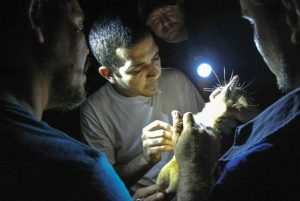
The University of Illinois and University of Puerto Rico have completely sequenced the mitochondrial genome for the Hispaniolan solenodon, filling in the last major branch of placental mammals on the tree of life.
The study, published in Mitochondrial DNA, confirmed that the venomous mammal diverged from all other living mammals 78 million years ago, long before an asteroid wiped out the dinosaurs.
“It’s just impressive it’s survived this long,” said co-first author Adam Brandt, a postdoctoral researcher at Illinois. “It survived the asteroid; it survived human colonization and the rats and mice humans brought with them that wiped out the solenodon’s closest relatives.”
The study also supports recent findings that the Dominican Republic contains genetically distinct northern and southern populations that should be conserved as separate sub-species. Furthermore, the study found that the southern population has little diversity, whereas the northern population is much more diverse.
An offspring’s nuclear DNA is a mixture of genes from each parent while mitochondrial DNA is passed directly from mother to offspring without changes, creating a genetic record that researchers can use to trace back the lineage of organisms.
Because solenodons are endangered, it is difficult to acquire DNA. Working with colleagues at several universities in the Dominican Republic, UPR Professor of Genetics Taras Oleksyk and his team collected samples by laying on the ground and waiting for the solenodons to crawl across their bodies.
Brandt and co-first author Kirill Grigorev, a bioinformatician at the Caribbean Genome Center, analyzed the samples using two different methods to determine the sequence of nucleotides (building blocks that make up DNA) of the solendon’s mitochondrial genome. Independently, the two methods produced the exact same results.
A previous study used a different set of genes to estimate that solenodons diverged from mammals during the Cretaceous Period 76 million years ago. Working with an expert at Texas A&M, this study used a very different method but still established a similar estimate: 78 million years.
Interestingly, these two estimates align with a hypothesis regarding how the solenodon came to inhabit the island of Hispaniola. Some geologists speculate that the island was part of a volcanic arc connected to Mexico 75 million years ago and over time the arc has moved eastward.
“Whether they got on the island when the West Indies ran into Mexico 75 million years ago, or whether they floated over on driftwood or whatever else much later is not very clear,” said lead researcher Alfred Roca, a professor of animal sciences and member of the Carl R. Woese Institute for Genomic Biology.
What they do know is that any close ancestors are long gone, and today’s solenodons are the only remnant of a very ancient group of mammals. While the solenodon is venomous and resembles a “giant rat with Freddy Krueger claws” (according to Roca), it evolved in the absence of carnivores. Today, it is threatened by cats and dogs introduced by humans as well as habitat loss.
The Dominican Republic made this study possible by supporting the collection of samples.
Reference:
Adam L. Brandt, Kirill Grigorev, Yashira M. Afanador-Hernández, Liz A. Paulino, William J. Murphy, Adrell Núñez, Aleksey Komissarov, Jessica R. Brandt, Pavel Dobrynin, J. David Hernández-Martich, Roberto María, Stephen J. O’Brien, Luis E. Rodríguez, Juan C. Martínez-Cruzado, Taras K. Oleksyk, Alfred L. Roca. Mitogenomic sequences support a north–south subspecies subdivision withinSolenodon paradoxus. Mitochondrial DNA Part A, 2016; 1 DOI: 10.3109/24701394.2016.1167891
Note: The above post is reprinted from materials provided by Carl R. Woese Institute for Genomic Biology, University of Illinois at Urbana-Champaign.










